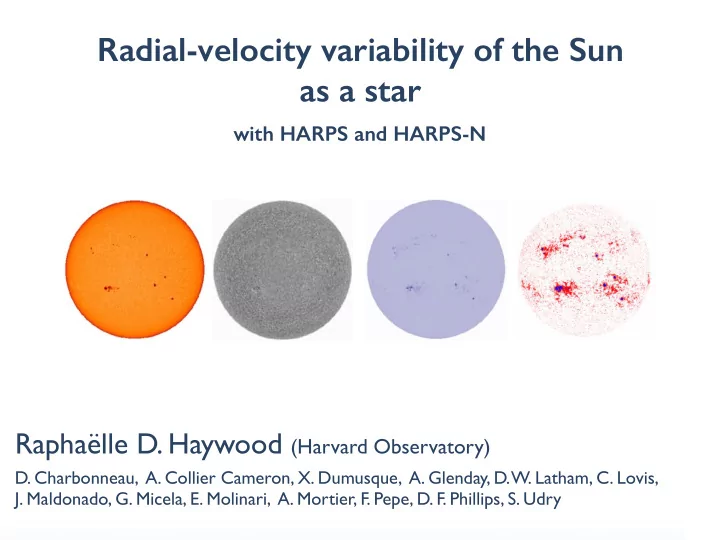

Radial-velocity variability of the Sun as a star with HARPS and HARPS-N Raphaëlle D. Haywood (Harvard Observatory) D. Charbonneau, A. Collier Cameron, X. Dumusque, A. Glenday, D. W. Latham, C. Lovis, J. Maldonado, G. Micela, E. Molinari, A. Mortier, F. Pepe, D. F. Phillips, S. Udry
Motivation Stellar activity is the main limitation in exoplanet radial-velocity (RV) searches • Can we observe the Sun as a star with a stellar spectrograph? • Can we reconstruct the disc-averaged RV of the Sun using high spatial resolution solar images? SDO Two experiments: 1. HARPS observations of sunlight reflected from asteroid Vesta 3.6m/HARPS solar/HARPS-N 2. HARPS-N observations of disc-integrated sunlight through the solar telescope
Experiment 1: sunlight scattered off Vesta Sun as-a-star Earth Observations span ~2 solar rotations taken during Sept. — Dec. 2011 Haywood et al. (2016)
Experiment 1: sunlight scattered off Vesta Sun as-a-star Earth Observations span ~2 solar rotations taken during Sept. — Dec. 2011 Haywood et al. (2016)
Reconstruct solar activity RV with SDO images Continuum Doppler image intensity Thresholded Magnetic image flux Technique developed by Meunier et al. (2010)
How do active regions induce radial-velocity variations? Star rotates Doppler Doppler More More shifts shifts redshift blueshift balanced balanced Rotational imbalance due to brightness inhomogeneities (~0.1 m/s)
How do active regions induce radial-velocity variations? Star rotates Doppler Doppler More More shifts shifts redshift blueshift balanced balanced Rotational imbalance due to Suppression of convective blueshift brightness inhomogeneities by magnetic regions (~0.1 m/s) (~few m/s)
How do active regions induce radial-velocity variations? Star rotates Doppler Doppler More More shifts shifts redshift blueshift balanced balanced Rotational imbalance due to Suppression of convective blueshift brightness inhomogeneities by magnetic regions (~0.1 m/s) (~few m/s) Earth orbit around Sun: 0.09 m/s!
Can we reconstruct the radial velocity of the Sun? HARPS Sun as-a-star (a) RVs Δ RV conv (b) Δ RV phot (c) Model (d) Residuals (e) Haywood et al. (2016) [m/s] Time [days]
Faculae are the main source of suppression of convective blueshift Faculae pixels Sunspot pixels
Optical lightcurves can only give incomplete prediction of RV variations Because sunspots and faculae are not completely co-spatial
Experiment 2: solar telescope at HARPS-N Full dataset since July 2015, 5-min cadence See X. Dumusque’s plenary talk on Thursday
Time-series of spectral line profile distortions seen by HARPS-N time velocity
Summary • We measured the disc-averaged radial-velocity variations of the Sun with two exoplanet-hunting spectrographs • The dominant contribution to activity-induced radial-velocity variations is suppression of convective blueshift via faculae, not spots (Meunier et al. 2010a, b, Haywood et al. 2016) • Studying distortions in the spectral line profiles will give us the proxies we need to correct the radial velocities of other stars
Recommend
More recommend